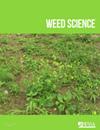Influence of cover crop residue and residual herbicide on emergence dynamics of glyphosate-resistant Palmer amaranth (Amaranthus palmeri) in grain sorghum
IF 2.1
2区 农林科学
Q2 AGRONOMY
引用次数: 0
Abstract
A field study was conducted from 2020 to 2023 at Kansas State University Agricultural Research Center near Hays, KS, to understand the emergence dynamics and periodicity of glyphosate-resistant (GR) Palmer amaranth (Amaranthus palmeri S. Watson) as influenced by cover crop (CC) residue and residual herbicide in grain sorghum [Sorghum bicolor (L.) Moench]. The study site was under a wheat (Triticum aestivum L.)–sorghum–fallow rotation with a natural seedbank of GR A. palmeri. Treatments included (1) fall-planted CC mixture [winter triticale (×Triticosecale Wittm. ex A. Camus [Secale × Triticum])/winter peas (Pisum sativum L.)/rapeseed (Brassica napus L.)/radish (Raphanus sativus L.)] after wheat harvest and terminated at triticale heading stage (next spring before sorghum planting) with glyphosate alone or (2) glyphosate plus acetochlor/atrazine, (3) chemical fallow (no CC but treated with acetochlor/atrazine and dicamba before sorghum planting), and (4) nontreated control (no CC and no herbicide). Results indicated that CC terminated with glyphosate plus acetochlor/atrazine had a delayed and reduced cumulative emergence of GR A. palmeri as compared with chemical fallow and CC terminated with glyphosate alone across all 3 yr. Compared with chemical fallow, the CC terminated with glyphosate alone and glyphosate plus acetochlor/atrazine required 66 to 643 and 105 to 1,257 more cumulative growing degree days, respectively, to achieve 90% cumulative emergence of GR A. palmeri across all 3 yr. The combined effect of CC residue with glyphosate plus acetochlor/atrazine reduced the total emergence counts of GR A. palmeri by 42% to 56% and 82% to 94% as compared with chemical fallow and nontreated control, respectively. These results suggest that fall-planted CC combined with a residual herbicide at termination can be utilized for GR A. palmeri suppression in grain sorghum.覆盖作物残留物和残留除草剂对谷物高粱中抗草甘膦帕尔默苋(Amaranthus palmeri)出苗动态的影响
2020 年至 2023 年,在堪萨斯州海斯附近的堪萨斯州立大学农业研究中心开展了一项田间研究,以了解谷物高粱[Sorghum bicolor (L.) Moench]中抗草甘膦(GR)的帕尔默苋(Amaranthus palmeri S. Watson)受覆盖作物(CC)残留物和残留除草剂影响的萌发动态和周期。研究地点为小麦(Triticum aestivum L.)-高粱-沼泽轮作区,有天然的棕叶高粱种子库。处理包括:(1)秋季种植 CC 混合物[冬三棱麦(×Triticosecale Wittm.小麦收割后,在三粒豆打顶期(来年春天高粱播种前)用草甘膦单剂或(2) 草甘膦加乙草胺/atrazine、(3) 化学休耕(无 CC,但在高粱播种前用乙草胺/atrazine 和麦草畏处理)和(4) 未处理对照(无 CC 和无除草剂)终止 CC。)结果表明,与化学休耕和仅使用草甘膦终止的 CC 相比,使用草甘膦加乙草胺/atrazine 终止的 CC 在所有 3 年中的 GR A. palmeri 累计出苗时间延迟,出苗率降低。与化学休耕和未处理的对照组相比,CC残留与草甘膦和乙酰甲胺磷/atrazine的综合效应分别使GR A. palmeri的总出苗数减少了42%至56%和82%至94%。这些结果表明,在谷物高粱的秋季种植 CC,并在结束时使用残留除草剂,可以有效抑制 GR A. palmeri。
本文章由计算机程序翻译,如有差异,请以英文原文为准。
求助全文
约1分钟内获得全文
求助全文
来源期刊

Weed Science
农林科学-农艺学
CiteScore
4.60
自引率
12.00%
发文量
64
审稿时长
12-24 weeks
期刊介绍:
Weed Science publishes original research and scholarship in the form of peer-reviewed articles focused on fundamental research directly related to all aspects of weed science in agricultural systems. Topics for Weed Science include:
- the biology and ecology of weeds in agricultural, forestry, aquatic, turf, recreational, rights-of-way and other settings, genetics of weeds
- herbicide resistance, chemistry, biochemistry, physiology and molecular action of herbicides and plant growth regulators used to manage undesirable vegetation
- ecology of cropping and other agricultural systems as they relate to weed management
- biological and ecological aspects of weed control tools including biological agents, and herbicide resistant crops
- effect of weed management on soil, air and water.
 求助内容:
求助内容: 应助结果提醒方式:
应助结果提醒方式:


